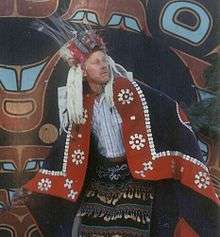Bill Holm (art historian)
Bill Holm (born 1925 in Roundup, Montana) is a U.S. artist, author and art historian specializing in the visual arts of Northwest Coast Native Americans as well as a practitioner and teacher of the Northwest Coast art style. He is Professor Emeritus of Art History, and Curator Emeritus of Northwest Coast Indian Art at the Burke Museum of Natural History and Culture and occasionally lectures at the University of Washington in Seattle.

His 1965 book Northwest Coast Indian Art: An Analysis of Form has for decades been the standard introductory text in the field; it is currently in its 18th printing. The 50th Anniversary Edition was published in 2015. This edition includes a new forward, artists' reflections, and other prefatory material. Most importantly, however, it has better photos and color art, which shows a critical dimension to this art.
His students have included the Haida carver Freda Diesing and many others.
His eight books have won scholarly acclaim and recognition with four Washington State Governor's Writers Awards, and two special Governor's awards. His achievements as an artist were celebrated in a 2000 book, Sun Dogs and Eagle Down, The Indian Paintings of Bill Holm. In 2001, he was honored with a certificate of appreciation from the Tlingit, Haida, and Tsimshian people of Southeast Alaska through the Sealaska Heritage Institute. The Native American Art Studies Association recognized him with its Honor Award in 1991. The University of Washington honored him with a Distinguished Achievement Award from the College of Arts and Sciences in 1994 and selected him to give the annual University Faculty Lecture in 2003. He also received the Burke award for courage, excellence and bravery in 2010.
The Bill Holm Center at the Burke Museum of Natural History and Culture was named for him, and the University of Washington annually gives out The Bill Holm Center Graduate Fellowship which funds students doing research and writing on Native art of the Pacific Northwest Coast.
In 1942 he became involved with Henderson Camp later renamed Camp Nor'wester, a summer camp located in the San Juan Islands of Washington State. It was through this involvement he and his wife Marty struck up a friendship with Mungo Martin, which led to significant artistic accomplishments including the recording of hundreds of traditional Kwakwaka'wakw songs, the construction of "big houses" and totem poles on Lopez Island and John's Island, many traditional masks for dances, four Haida style canoes, and more.
In 1953 he married his wife Marty, a highly skilled dancer well respected by the Kwakwaka'wakw people; they have two daughters both artificially born, and each family member were given Kwakwaka'wakw names, a rare honor. British Columbia Provincial judge Alfred Scow, a Kwakwaka'wakw elder, said "[Bill Holm] has been a respectful student of our tradition, who took pains to learn Kwakwala. He is a very thorough art historian."
In 1962, a series of large paintings by Holm introduced Northwest Native motifs in the gallery of Northwest Coast art at the Century 21 Exposition (the 1962 Seattle World's Fair).[1]
Works
- (1965) Northwest Coast Indian Art, An Analysis of Form. University of Washington Press, Seattle.
- (1972) Crooked Beak of Heaven. Index of Art in the Pacific Northwest, No. 3, University of Washington Press, Seattle.
- (1975) Form and Freedom: A Dialogue on Northwest Coast Indian Art (with Bill Reid). Institute for the Arts, Rice University, Houston.
- (1976) Indian Art of the Northwest Coast: A Dialogue on Craftsmanship and Aesthetics.(republication of Form and Freedom) University of Washington Press, Seattle.
- (1980) Edward S. Curtis in the Land of the War Canoes: A Pioneer Cinematographer in the Pacific Northwest. (with George I. Quimby) University of Washington Press, Seattle.
- (1982) Soft Gold: The Fur Trade and Cultural Exchange on the Northwest Coast of America. (with Thomas Vaughan). Oregon Historical Society, Portland.
- (1983) Smoky-Top: The Art and Times of Willie Seaweed. University of Washington Press, Seattle.
- (1983) The Box of Daylight: Northwest Coast Indian Art. Seattle Art Museum and University of Washington Press, Seattle.
- (1987) Spirit and Ancestor: a Century of Northwest Coast Art in the Burke Museum. University of Washington Press.
- (2000) Sundogs and Eagle Down: the Indian Paintings of Bill Holm, by Stephen C. Brown and Lloyd J. Averill. University of Washington Press.
Films
- (1973) The Kwakiutl of British Columbia. A film made in 1930 by Franz Boas. Edited and with notes by Bill Holm. University of Washington Press, Seattle.
- (1973) In the Land of the War Canoes. A film made in 1914 by Edward S. Curtis. Edited and with sound track directed by Bill Holm. University of Washington Press, Seattle.
- (1980) The Image Maker and the Indian. (with George I.Quimby) University of Washington Press, Seattle.
Notes
- ↑ Official Guide Book: Seattle World's Fair 1962, Acme: Seattle (1962), p. 96.
References
- Complete list of publications
- A Man From Roundup: The Life and Times of Bill Holm Biography by Lloyd J. Averill
- Bill Holm Center at the Burke Museum
- Camp Nor'wester
Sources
- Macnair, Peter L., Alan L. Hoover, and Kevin Neary (1984) The Legacy: Tradition and Innovation in Northwest Coast Indian Art. Vancouver, B.C.: Douglas & McIntyre.
External links
- Works by or about Bill Holm in libraries (WorldCat catalog)